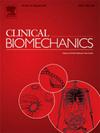Dynamic femoral head coverage following periacetabular osteotomy for developmental dysplasia of the hip
IF 1.4
3区 医学
Q4 ENGINEERING, BIOMEDICAL
引用次数: 0
Abstract
Background
Developmental dysplasia of the hip reduces hip stability due to insufficient femoral head coverage. Periacetabular osteotomy surgery aims to increase this coverage. Typically measured using radiographs, most coverage assessments are limited to static hip positions and cannot capture 3D anatomy. This study quantified how dynamic 3D femoral coverage changes during gait and squat after periacetabular osteotomy surgery and compared dynamic coverage to static measures.
Methods
Pre- and post-surgery CT scans from 38 patients with hip dysplasia were used to reconstruct 3D femur and pelvis bones with which gait and squat were simulated. Models of 38 control subjects were also created. The femoral head was divided into anteromedial, anterolateral, posteromedial, and posterolateral regions. Regional coverage was compared pre- and post-surgery, and against controls, in a static neutral position, during the stance phase of gait, and throughout the squat cycle.
Findings
Lateral coverage increased post-surgery in the static neutral position (anterolateral: 4.9 ± 3.6 % to 13.8 ± 5.6 %; posterolateral: 22.9 ± 15.4 % to 39.8 ± 15.2 % (p ≤ 0.001)) and throughout gait and squat (p ≤ 0.001). Average changes in neutral anterolateral coverage (+8.9 ± 4.5 %) were similar to average changes during gait (+8.1 ± 3.0 %), but not squat (+12.0 ± 1.9 %). Static neutral coverage post-surgery differed significantly from dynamic coverage in every region of the femoral head during all of gait, and most of squat.
Interpretation
While static measures follow some patterns of dynamic coverage after surgery, they miss important variations that can impact joint loading. Understanding how periacetabular osteotomy changes dynamic femoral head coverage can aid with operative planning and assessment to optimize outcomes during daily activities.
髋臼周围截骨术后动态股骨头覆盖治疗髋关节发育不良
背景:由于股骨头覆盖不足,髋关节发育不良降低了髋关节的稳定性。髋臼周围截骨手术旨在增加这一覆盖率。通常使用x光片测量,大多数覆盖评估仅限于静态髋关节位置,无法捕获3D解剖结构。本研究量化了髋臼周围截骨手术后步态和深蹲期间动态三维股骨覆盖范围的变化,并将动态覆盖范围与静态测量进行了比较。方法对38例髋关节发育不良患者进行术前及术后CT扫描,重建股骨和骨盆三维骨骼,模拟步态和深蹲。还建立了38个对照对象的模型。股骨头分为前内侧区、前外侧区、后内侧区和后外侧区。区域覆盖比较术前和术后,并与对照,在静态中立位置,在步态的站立阶段,整个深蹲周期。结果:手术后静态中立位的侧位覆盖率增加(前外侧:4.9±3.6%至13.8±5.6%;后外侧:22.9±15.4%至39.8±15.2% (p≤0.001)),整个步态和深蹲(p≤0.001)。中性前外侧覆盖的平均变化(+8.9±4.5%)与步态时的平均变化(+8.1±3.0%)相似,但与深蹲时的平均变化(+12.0±1.9%)不同。术后静态中性覆盖与动态覆盖在所有步态和大部分深蹲期间股骨头的每个区域有显著差异。虽然静态测量遵循手术后动态覆盖的一些模式,但它们忽略了可能影响关节负荷的重要变化。了解髋臼周围截骨术如何改变动态股骨头覆盖范围有助于手术计划和评估,以优化日常活动中的结果。
本文章由计算机程序翻译,如有差异,请以英文原文为准。
求助全文
约1分钟内获得全文
求助全文
来源期刊

Clinical Biomechanics
医学-工程:生物医学
CiteScore
3.30
自引率
5.60%
发文量
189
审稿时长
12.3 weeks
期刊介绍:
Clinical Biomechanics is an international multidisciplinary journal of biomechanics with a focus on medical and clinical applications of new knowledge in the field.
The science of biomechanics helps explain the causes of cell, tissue, organ and body system disorders, and supports clinicians in the diagnosis, prognosis and evaluation of treatment methods and technologies. Clinical Biomechanics aims to strengthen the links between laboratory and clinic by publishing cutting-edge biomechanics research which helps to explain the causes of injury and disease, and which provides evidence contributing to improved clinical management.
A rigorous peer review system is employed and every attempt is made to process and publish top-quality papers promptly.
Clinical Biomechanics explores all facets of body system, organ, tissue and cell biomechanics, with an emphasis on medical and clinical applications of the basic science aspects. The role of basic science is therefore recognized in a medical or clinical context. The readership of the journal closely reflects its multi-disciplinary contents, being a balance of scientists, engineers and clinicians.
The contents are in the form of research papers, brief reports, review papers and correspondence, whilst special interest issues and supplements are published from time to time.
Disciplines covered include biomechanics and mechanobiology at all scales, bioengineering and use of tissue engineering and biomaterials for clinical applications, biophysics, as well as biomechanical aspects of medical robotics, ergonomics, physical and occupational therapeutics and rehabilitation.
 求助内容:
求助内容: 应助结果提醒方式:
应助结果提醒方式:


